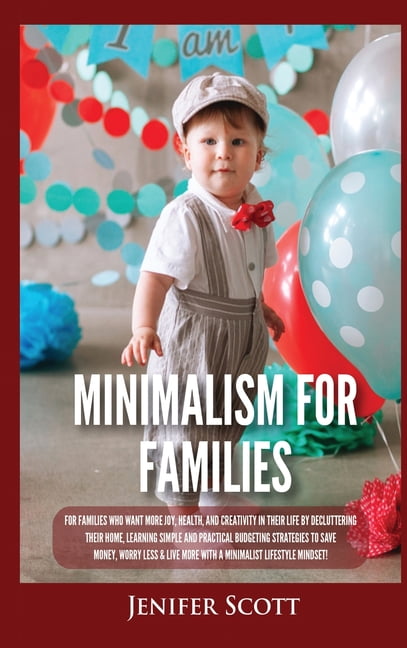30 Days To Minimalism: A Practical Guide To Decluttering Your Life

Table of Contents
Week 1: Assessing and Planning Your Minimalist Journey
Before diving into the decluttering process, it's crucial to plan your minimalist journey effectively. This initial week focuses on assessment and goal-setting, laying the foundation for a successful transformation.
Identifying Your Clutter Hotspots:
The first step in decluttering is identifying the areas in your home where clutter accumulates most. These are your "clutter hotspots." Common culprits include closets, drawers, countertops, and storage spaces.
- Identify: Take a walk through your home and note down areas overflowing with items. Be honest – even small areas contribute to overall clutter.
- Document: Take before photos of these areas. This visual record will serve as powerful motivation as you progress through the 30 days and witness the transformation. Seeing the "before" and "after" is incredibly rewarding.
- Checklist: Use a decluttering checklist to systematically work through each space. A methodical approach prevents feeling overwhelmed. You can create your own or find free templates online. This is key to effective declutter your home.
- Prioritize: Focus on the areas that bother you the most first. Tackling the most visually impactful clutter initially will boost your motivation.
Setting Realistic Goals:
Attempting to declutter your entire home in a week is unrealistic and often leads to burnout. Instead, set small, achievable goals.
- Small Steps: Focus on one area per day or week, depending on its size and the level of clutter. A small, consistent effort is more effective than sporadic bursts of activity.
- Daily/Weekly Targets: Set specific, measurable, achievable, relevant, and time-bound (SMART) goals. For example, "Declutter one drawer in the kitchen today" or "Clear the top of my desk this week."
- Lifestyle Fit: Create a minimalist plan that integrates seamlessly into your daily schedule. It should not disrupt your life, but rather improve it.
- Flexibility: Be flexible. If you fall behind, adjust your schedule accordingly. The aim is to develop a sustainable system, not to rigidly adhere to a timeline. Achieving minimalism is a process.
The 20/20 Rule & Other Decluttering Strategies:
Several proven strategies can simplify the decluttering process. Here are a few to incorporate into your plan:
- 20/20 Rule: If an item costs less than $20 and can be replaced in under 20 minutes, it's generally easier to let go. This rule helps with the decision-making process for inexpensive items.
- One-In, One-Out: For every new item you bring into your home, remove a similar item. This prevents future clutter accumulation. This is a simple but powerful minimalist rule.
- Four-Box Method: Categorize items into four boxes: keep, donate, sell, and trash. This structured approach streamlines the sorting process. Effective methods for decluttering your home include the four-box method.
Week 2: Tackling Clothes and Accessories
Clothes and accessories often contribute significantly to household clutter. This week focuses on decluttering your wardrobe.
The KonMari Method for Clothing:
The KonMari Method, developed by Marie Kondo, emphasizes keeping only items that "spark joy."
- Spark Joy: Hold each item of clothing in your hands and ask yourself if it sparks joy. If not, thank it for its service and let it go.
- Donation/Sale: Donate or sell items that no longer bring you joy. Consider selling high-value items to recoup some costs.
- Vertical Folding: Fold clothes vertically to maximize space and improve visibility. This helps organize your closet effectively. This is also part of the KonMari method.
Decluttering Shoes and Accessories:
Shoes and accessories often get overlooked during decluttering.
- Assess Functionality/Sentimental Value: Determine if your shoes and accessories are functional and if they hold sentimental value.
- One-Year Rule: Donate or sell items you haven't used in a year. This is a great rule of thumb for reducing clutter.
- Efficient Organization: Organize the remaining items efficiently using shoe racks, jewelry boxes, or other storage solutions.
Week 3: Conquering Papers and Digital Clutter
Paper and digital clutter often goes unnoticed, yet it contributes significantly to stress and disorganization.
Paper Decluttering:
Paper clutter accumulates quickly. Implementing a system for managing paper is essential.
- Shredding: Shred sensitive documents securely. This protects your personal information.
- Digitization: Digitize important documents and store them securely in the cloud or on external hard drives.
- Recycling: Recycle unnecessary papers immediately to prevent pile-ups.
- System: Establish a system for managing incoming paper, like a designated inbox or filing system. This will help you keep your workspace organized.
Digital Minimalism:
Digital clutter can be just as overwhelming as physical clutter.
- Unsubscribe: Unsubscribe from unnecessary emails to reduce inbox overload.
- Delete: Delete unused apps and files from your computer and phone. This frees up storage space and declutters your digital life.
- Organize: Organize your computer files into a logical system for easy retrieval. This will significantly improve your workflow.
- Backup: Back up important data regularly to prevent data loss.
Week 4: Maintaining Your Minimalist Lifestyle and Reflecting on Your Journey
The final week focuses on maintaining your progress and setting future goals.
Creating and Maintaining a Minimalist Home:
Minimalism isn't a one-time event; it's a lifestyle choice.
- Routines: Develop routines for daily tidying to prevent clutter from accumulating again.
- Regular Assessment: Regularly assess your belongings to ensure you're maintaining a minimalist approach.
- Mindful Consumption: Avoid impulse purchases and practice mindful consumption by considering whether you truly need an item before buying it.
- Simple Living: Embrace a simple living approach to reduce stress and improve your overall well-being.
Reflecting on Your Progress and Setting Future Goals:
Take time to reflect on your achievements and plan for the future.
- Evaluation: Evaluate your progress over the past 30 days. What worked well? What could be improved?
- Areas for Improvement: Identify areas where you could maintain a more minimalist approach.
- New Goals: Set new goals for maintaining your minimalist lifestyle in the long term. This ensures continued progress and prevents backsliding.
Conclusion:
Embracing minimalism is a journey, not a destination. This 30-day guide provides a framework to help you declutter your life and create a more intentional, peaceful existence. By consistently applying these strategies, you can transform your home and your mindset, creating a space that reflects your values and enhances your well-being. Start your journey to a simpler life today! Begin your minimalism journey now and experience the transformative power of decluttering your life. Download our free checklist (link here if applicable) to help you on your minimalist lifestyle path!

Featured Posts
-
 Local Man Matthew Sexton Convicted On Animal Pornography Charges
May 31, 2025
Local Man Matthew Sexton Convicted On Animal Pornography Charges
May 31, 2025 -
 Are Corporate Veterinary Practices Pushing Up Pet Owner Costs In The Uk
May 31, 2025
Are Corporate Veterinary Practices Pushing Up Pet Owner Costs In The Uk
May 31, 2025 -
 Observations Sur L Ingenierie Des Castors Dans Deux Cours D Eau De La Drome
May 31, 2025
Observations Sur L Ingenierie Des Castors Dans Deux Cours D Eau De La Drome
May 31, 2025 -
 Kpc News Delving Into The Past
May 31, 2025
Kpc News Delving Into The Past
May 31, 2025 -
 Owning A Piece Of Banksy History Six Screenprints And A Handmade Tool
May 31, 2025
Owning A Piece Of Banksy History Six Screenprints And A Handmade Tool
May 31, 2025
